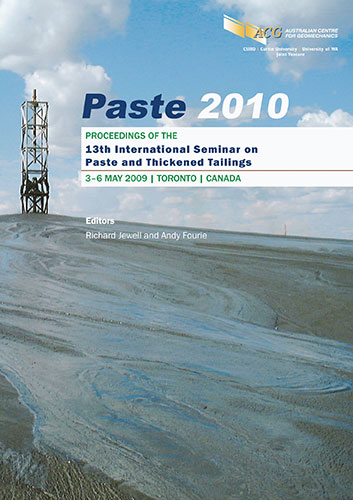Hydraulic response in cemented paste backfill during and after hydration

|
Authors: Witteman, M; Simms, P |
DOI https://doi.org/10.36487/ACG_rep/1063_17_Witteman
Cite As:
Witteman, M & Simms, P 2010, 'Hydraulic response in cemented paste backfill during and after hydration', in R Jewell & AB Fourie (eds), Paste 2010: Proceedings of the Thirteenth International Seminar on Paste and Thickened Tailings, Australian Centre for Geomechanics, Perth, pp. 199-207, https://doi.org/10.36487/ACG_rep/1063_17_Witteman
Abstract:
The distribution of pore-pressures in mine stopes may have important implications to the design of cemented paste backfill (CPB) systems. Self-weight consolidation after filling stopes is inherently problematic when pore-water pressures begin to develop. However, during cement hydration, self-desiccation begins to occur and consequently, pore-water pressures gradually dissipate. In some cases, during self-desiccation, matric suctions can develop within stopes, depending upon adopted mining strategies such as, fill rate and percent water to binder content. Tracking the evolution and quantifying the hydraulic behaviour in cemented paste is rather difficult because of the complexity of the hydrating material. The current study investigates and attempts to capture CPB’s transient responses during and after cement hydration through a series of self- desiccation tests and axis translation tests. Self-desiccation tests are conducted on cemented paste specimens containing 0, 3, 5 and 7% wt binder material. The water-retention properties of the material are measured without binder, and after 28 days of hydration. This data is then used to approximately model the dissipation of pore-water pressures measured at the bottom of stope during a plug pour. The approach shows promise. Significance and future improvement to the proposed methodology are discussed.
References:
Acker, P. (2004) Swelling, shrinking and creep: a mechanical approach to cement hydration, Materials and
Structures/Concrete Science and Engineering, 37, pp. 237–243.
Belem, T., Bussiere, B. and Benzaazoua, M. (2001) The effect of microstructural evolution on the physical properties of
paste backfill, In Proceedings Tailing and Mine Waste 2001, A.A. Balkema, pp. 365–374.
Belem, T., Harvey, A., Simon, R. and Aubertin, M. (2004) Measurement and prediction of internal stresses in an
underground opening during its filling with cemented fill, In Proceedings 5th International Symposium on
Ground Support in Mining and Underground Construction, pp. 619–630.
Belem, T. and Benzaazoua, M. (2008) Design and application of underground mine paste backfill technology,
Geotechnical and Geological Engineering, Vol. 26(2008), pp. 147–174.
Decagon Devices Inc. (2007) Operator’s manual for models WP4 and WP4-T, Dewpoint PotentiaMeter.
Fourie, A., Helinski, M. and Fahey, M. (2006) Filling the gap – a geomechanics perspective, Australian Centre for
Geomechanics, Perth, Australia, Newsletter 26, pp. 1–4.
Grabinsky, M. and Simms, P. (2006) Self-desiccation of cemented paste backfill and implications for mine design, In
Proceedings Ninth International Seminar on Paste and Thickened Tailings, Australian Centre for Geomechanics,
Perth, Australia, pp. 323–336.
Grabinsky, M. and Bawden, W.F. (2007) In situ measurements of geomechanical design of cemented paste backfill
systems, In Proceedings Minefill 2007 (Paper No. 2456), [CD-ROM].
Helinski, M., Fourie, M., Fahey, M. and Ismail, M. (2007) Assessment of the self-desiccation process in cemented mine
backfills, Canadian Geotechnical Journal, Vol. 44, pp. 1148–1156.
Hilf, J.W. (1956) An investigation of pore-water pressure in compacted cohesive soil, Ph.D. thesis, Technical
Memorandum 654, U.S. Department of the Interior Bureau of Reclamation, Denver, Colorado.
Hua, C., Acker, P. and Ehrlacher, A. (1995) Analyses and models of the autogenous shrinkage of hardening cement
paste, Cement and Concrete Research, Vol. 25(7), pp. 1457–1468.
Kim, J-K. and Lee, C-S. (1999) Moisture diffusion of concrete considering self-desiccation at early ages, Cement and
Concrete Research, Vol. 29, pp. 1921–1927.
le Roux, K. (2004) In situ properties and liquefaction potential of cemented paste backfill, PhD thesis, Graduate
department of civil engineering, University of Toronto, Canada.
Li, L., Aubertin, M. and Belem, T. (2005) Formulation of a three dimensional analytical solution to evaluate stresses in
backfilled vertical narrow openings, Canadian Geotechnical Journal, Vol. 42, pp. 1705–1717.
Simms, P. and Grabinsky, M. (2009) Direct measurement of matric suction in triaxial tests on early-age cemented paste
backfill, Canadian Geotechnical Journal, Vol. 46, pp. 93–101.
Umwelt-Monitoring-Systeme (UMS) (2009) User Manual: T5/T5x pressure transducer tensiometer, Ver 12/2009, UMS
GmbH Munchen.
Hydraulic response in cemented paste backfill during and after hydration M. Witteman and P. Simms
208 Paste 2010, Toronto, Canada
© Copyright 2026, Australian Centre for Geomechanics (ACG), The University of Western Australia. All rights reserved.
View copyright/legal information
Please direct any queries or error reports to repository-acg@uwa.edu.au
View copyright/legal information
Please direct any queries or error reports to repository-acg@uwa.edu.au